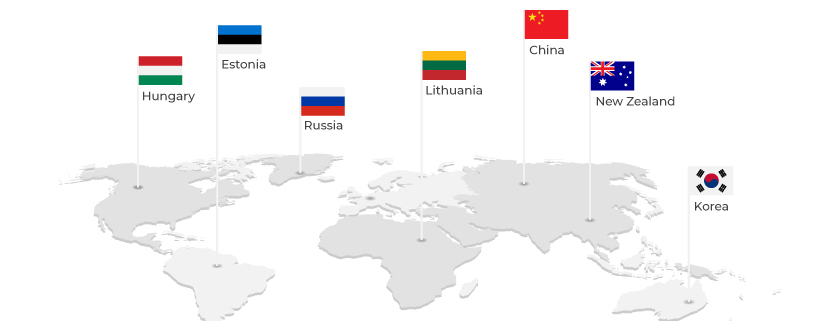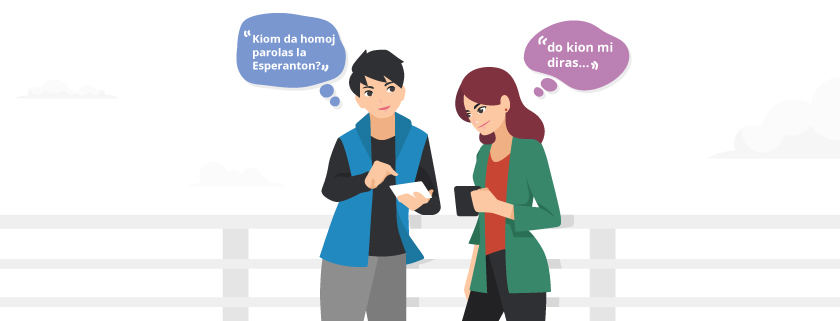Did you know that there is a language that was invented by humans and did not evolve naturally? Unlike the naturally evolving languages, this language does not have ancient morphology and form that existed thousands of years ago and is one of the most widely spoken invented languages in the world. According to recent estimates, there are more than 7000 languages in the world today. The question here arises–why was there a need to invent a new one like the Esperanto language?
Some constructed languages have come into existence simply because of serving entertainment purposes such as Klingon, the language used in Star Trek. This constructed language became so popular that it gained the status of popular constructed language in the world.
However, some languages such as the Esperanto language were invented to bring people together and to make communication between different communities easier. Being an invented language, it makes sense that it has a fewer number of speakers than the natural languages, but how many people actually speak Esperanto? Let us find out.
Table of Content
What is Esperanto?
When you hear the word “Esperanto”, the first thing that might pop up in your mind is a language that is related to the Spanish language or a language of Romance origin. The truth is that Esperanto is a constructed auxiliary language created by a doctor named L.L. Zamenhof in 1887. Esperanto was created to assume the status of a global second language, as well as to promote world peace and unity.
- Similarity With Roman Language
To say that Esperanto holds similarities to Romance languages would not be wrong. Esperanto has roots in Latin and Romance languages and is inspired by French and Spanish languages. If we take a look at the history of the Esperanto language, we will see that Zamenhof invented the language as a “neutral” language to facilitate and promote world peace. The idea of making this “International Auxiliary Language” (IAL) was to design a language that is not anyone’s mother tongue but can be learned as a second language by people to make communication easy for anyone across the world.
Esperanto language’s roots lie largely in Latin, with influences from Polish, English, Russian, and German. These influences from multiple languages were taken to make it an easier language to learn. It was also done so that people of Latin or Spanish origin will be able to learn the language faster. This is true as many of the Esperanto speakers claim that due to its simple grammar, Latin vocabulary, and phonetics, Esperanto is easier to learn than other languages and can be quickly learned as well.
Who Speaks the Esperanto Language?

According to recent research, there are approximately two million speakers of the Esperanto language worldwide. Even though Esperanto was invented to be an auxiliary language, there are about 1000 speakers of Esperanto language who speak it as their first language. This shows how many people are willing to take Zamenof’s idea of a “neutral” language forward and use it in their lives.
The Esperanto language does not have official status in any country, and that is the language’s success. There are books, music, and entertainment present in this language, and an event solely dedicated to the growth and promotion of the Esperanto language. This event, termed the biggest event for any language, is known as Universala Kongreso and was founded by Zamenhof. This event takes place in different cities almost every year since 1905 and was started as a way to discuss as well as promote the Esperanto language. Nowadays, the event is held to celebrate the Esperanto language and its advances. Likewise, Spanish language day is celebrated on the 23rd of April.
Although the exact numbers are not clear, there are approximately 1000 people who speak Esperanto as their native language. About 10,000 people are fluent speakers of Esperanto, and 100,000 are active users. Moreover, approximately 1,000,000 people understand Esperanto in a passive sense and about 10,000,000 people have studied this language at some point in their lives.
Why is the Esperanto Language Spoken?

There are thousands of natural languages in the world and people actively take part in learning and speaking a natural language. Here the question arises about the need to learn a constructed language.
So why do people actually speak Esperanto while there are other natural languages out there?
While some people see speaking Esperanto as a challenge, others want to promote Zamenhof’s idea of world peace. However, the most commonly cited reason for learning Esperanto is the community itself. Speakers of the Esperanto language reach out to their communities in addition to gathering together every year for the promotion and growth of the Esperanto language.
The internet and social media have also given a massive boom to this language and there is a large community of Esperanto speakers one can find online who are willing to teach Esperanto to people. In addition, there is also a radio station and local groups that speak and teach the Esperanto language.
Where is the Esperanto Language Spoken?

Esperanto may be a language with a few million speakers but these speakers are dispersed and present in many countries. Unlike the natural languages, the speakers of the Esperanto language have learned the language from other people and have not learned it via the mother tongue. Nevertheless, there are a few countries where the Esperanto language is spoken.
These are some of the countries where the Esperanto language is spoken:
1. Hungary
Hungary has a high number of Esperanto speakers, due to the language being offered in schools and colleges. Interestingly, Hungary is also one of the few countries that include a language knowledge question in its census. The last census revealed that there are approximately 8397 Esperanto speakers in Hungary.
2. Estonia
In its latest census, it was revealed that Estonia has about 209 Esperanto speakers, which turns out to be about 158 speakers per million. Considering the total population of this small country, this number is quite high.
3. Russia
Being a very large country with a horde of different languages spoken in it, Russia also has Esperanto speakers. But the number of Esperanto speakers is so small that it is insignificant in comparison to the other languages spoken in the country. According to the latest census, there are only 992 Esperanto speakers in Russia, which accounts for only seven people per million.
4. Lithuania
There are approximately 604 Esperanto speakers in Lithuania, which equates to 204 people per million.
5. China
China is among the few countries which had a large number of Esperanto speakers in the past. During the 1980s, Esperanto was listed as a popular foreign language to learn for the Chinese people, and there were approximately 300,000 to 400,000 Esperanto speakers in the country. This number eventually dropped through the years, and there are currently 10,000 active speakers and 400,000 passive speakers of the Esperanto language in China.
6. New Zealand
New Zealand has the highest population of Jedis in the world and is, therefore, viewed as a country that will be quick to adopt a constructed language. However, there are only 123 Esperanto speakers in New Zealand, amounting to 28 speakers for every million.
7. Korea
Korea is the first Asian country that hosted the World Esperanto Congress in 1994. In fact, the Esperanto department at the Dankook University of South Korea is listed as one of the best departments for Esperanto speakers. This goes to show the popularity of Esperanto speakers in Korea.
Why Learn the Esperanto Language in 2025?

Esperanto language may be a constructed and invented language, but it is one of the most useful languages to learn in the future. Granted, Esperanto is still an evolving language and has only a few numbers of speakers in comparison to other languages, but there are certain advantages of learning the Esperanto language that is listed below:
1. Ease of learning
The Esperanto language is fairly easy to learn and is not complex. The language itself is similar to multiple world languages and this makes it easier to learn and speak. Learning and speaking the Esperanto language in the future will be easy too, considering the many sources available for learning, such as online videos and books.
2. Global Language
The Esperanto language was formulated and invented as a neutral language to act as a common second language between communities. This is the reason why it is not spoken as a mother tongue anywhere and is a global language for learning and speaking. The status of the International Auxiliary Language (IAL) of Esperanto makes it a global language that anybody can learn. This is also one of the reasons the Esperanto language should be learned in the future as it is a global language that is likely to gain popularity in the coming years.
3. Neutral Language
A neutral language is a language that does not belong to a single community or locality, and Esperanto is an artificially constructed language. The neutrality of the Esperanto language makes it an interesting language to learn. The good thing is that anyone can learn to speak and write in Esperanto, so nobody is at a disadvantage. Although there are still some native speakers of the Esperanto language, it is not the mother tongue of any region.
4. For Traveling Purposes
Suppose you are a tourist wanting to visit different countries. You will find that learning Esperanto will help you to communicate effectively in areas where Romance languages are spoken, such as Spain and Italy. Even if you fail to find an Esperanto speaker in your target location, you will still find it easy to communicate if you understand the Esperanto vocabulary and grammar.
5. For Entertainment Purposes
The Esperanto language is not just confined to a single community or space. It is a language that is learned and spoken by a sizeable number of people. This also means that it is used for entertainment purposes such as in movies, theaters, and the music industry. Learning the Esperanto language can open doors for availing more entertainment avenues in the wider world.
6. The Language of the Future
The Esperanto language is a rapidly evolving language that is likely to gain more popularity in the future. As natural languages continue to evolve and change the form, there is a need for a language that does not have its native roots anywhere but can be learned and spoken by anyone. This is why it is encouraged to learn the Esperanto language in 2025 as this language is likely to gain more popularity in the coming years.
How to Learn the Esperanto Language?

Just like any other language, the Esperanto language can be learned with the help of online tutoring and guidance. Here are a few methods you can use to learn the Esperanto language:
- Online through online tutoring and social media platforms
- Through newspapers and books
- Through movies and films in the Esperanto language
- Hiring an online tutor
- Watching online videos and language tutorials
A language can best be learned by speaking and interacting with the native speakers of that language. If you wish to speak the Esperanto language, all you have to do is speak and learn from the Esperanto speakers. Speaking with these people directly will enable you to get more fluent in the language as well as understand the vocabulary of this constructed language.
Key Takeaway
The Esperanto language is unique, but beautifully constructed language invented by L.L. Zamenhof, who created this language as a means to bring unity and a common language for everyone. Unlike the natural languages which are spoken as a mother tongue, the Esperanto language is not spoken as a mother tongue anywhere, but it has a sizeable number of speakers in the world. Learning and speaking in the Esperanto language should be learned for the future as well, as it is not just a language, but a means to establish communication with other people around the globe.



